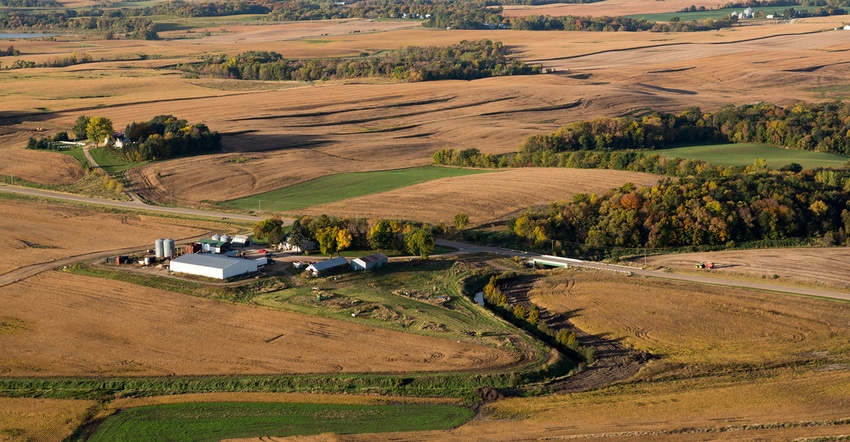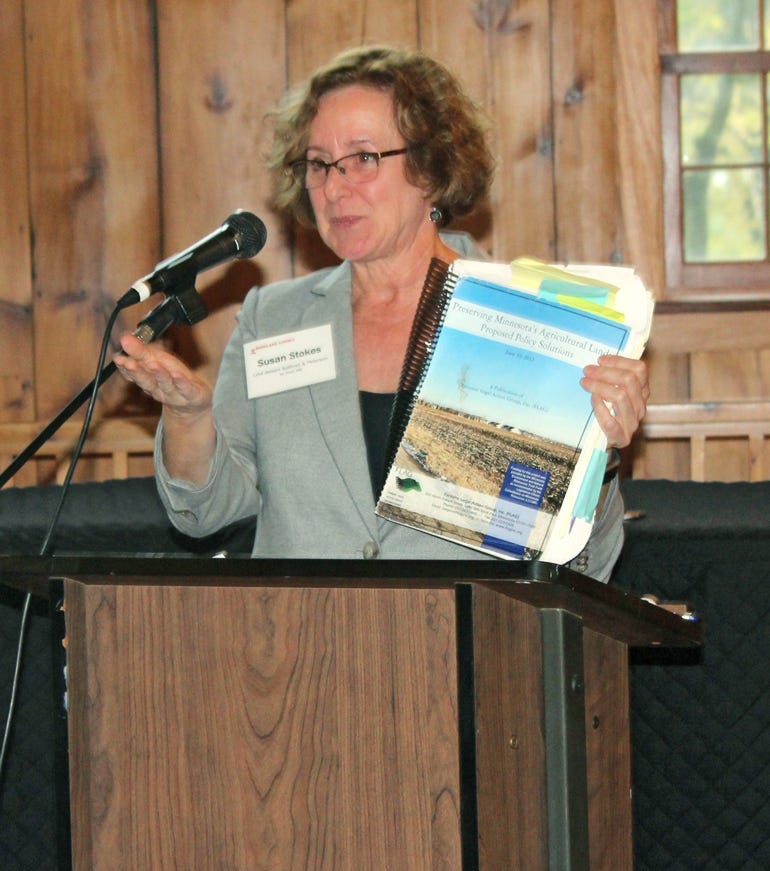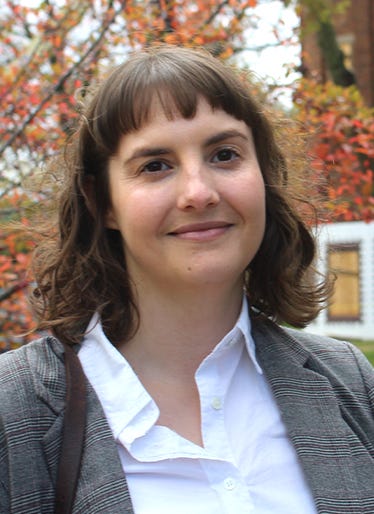
Close your eyes and envision a farmer. Did you think of a 60ish white man driving a tractor in a field of corn or soybeans?
In Minnesota, the average farmer is a 56.5-year-old white male who operates a family farm, according to the USDA Census of Agriculture. He practices tillage on his 370 acres and generates 55% of his income from crop sales.
Yet, a host of factors are challenging this vision: Changing climate, soil degradation, aging farmers, farm transitions and a new generation of first-time farmers who desire to farm differently.
These issues were among those discussed at The Upper Midwest Farmland Summit, held Oct. 21 at the Anderson Center in Red Wing, where years earlier Alexander Anderson conducted experiments that led to the creation of Quaker Puffed Rice and Quaker Puffed Wheat cereals.
Just as Anderson experimented, the farmers of today must also embrace an innovative mindset, said Fred Kirschenmann, a distinguished fellow at the Leopold Center for Sustainable Agriculture at Iowa State University and president of Stone Barns Center for Food and Agriculture in Pocantico Hills, N.Y.
There are challenges ahead with the same old way of doing things not working anymore.
“We’ve got some difficult times ahead of us,” said Kirschenmann, who was born on a North Dakota farm during the Great Depression. Yet, he said, “challenges are also opportunities.”
He referenced the David Montgomery book, “Growing a Revolution: Bringing Our Soil Back to Life,” as a guide. In the book, Montgomery profiles farmers who don’t till the soil, use cover crops and practice crop rotation.
Sustainable land management is mentioned as a way to protect communities from the impacts of more intense rainfall in the recent Intergovernmental Panel on Climate Change report, he said. But farmers can’t make changes on their own. Instead, it must be a systems approach with society engaging and deciding how they want their food produced. The farmers of today need to anticipate changes ahead and prepare for them today while partnering and learning from nature.
“Things will not be tomorrow as they are today,” Kirschemann said.
Policy change
A warmer climate is ushering in changes for Minnesota agriculture, said Susan Stokes, an attorney with the firm Lind, Jensen, Sullivan & Peterson, Minneapolis, and a former assistant commissioner at the Minnesota Department of Agriculture. New pests are emerging and there are more intense rainfall events and more drought. It’s not if there will be a natural disaster, it’s when.
In addition to societal changes Kirschemann mentioned, Stokes said policies need to be developed to help farmers become more resilient.
She advocated changing the long-held view of farmland as a temporary state and creating support for preserving farmland. Farmland is not vacant land waiting to be developed.
 AT THE TABLE: Attorney Susan Stokes said it is important for all voices to have a seat at the table when discussing farmland in Minnesota.
AT THE TABLE: Attorney Susan Stokes said it is important for all voices to have a seat at the table when discussing farmland in Minnesota.

“It should be really, really hard to develop farmland,” she said.
Minnesota has a patchwork approach to farmland preservation and stronger policies are needed, she added.
Minnesota has two state agricultural land preservation programs: The Metropolitan Agricultural Preserves Program, which includes the seven-county Twin Cities metro area and is run by the Metropolitan Council; and the Minnesota Agricultural Land Preservation Program, which is available in greater Minnesota. Currently, Winona, Waseca and Wright counties participate in the outstate program.
A lot could be done with these programs, Stokes said, but now neither is well-funded nor well-used. She suggests consolidating and improving the programs. Perhaps have a mitigation proposal similar to the wetland credit system, perhaps set up tiers with more value going to land with healthier soil, she added.
The Minnesota Agricultural Water Quality Certification Program has shown there is an interest in farm practices that improve water quality. As of mid-October, 802 producers had voluntarily signed up for the program, covering 544,215 acres. The farmers enrolling in this program could receive additional incentives, she said, alluding to possible policy modifications that would allow for rewarding specific practices.
Minnesota must also maintain its corporate farm law, Stokes said.
Moving forward, it’s essential that everyone have a seat at the table when discussing farmland in Minnesota.
“We’re going to get it wrong if we don’t have the right voices at the table,” Stokes said.
New voices
More new farmers are from non-farm backgrounds and they are choosing to farm and live differently, according to Kathy Ruhf of Land for Good, a New Hampshire based organization that aims to get more farmers on the land in six New England states.
According to a 2017 survey commissioned by the National Young Farmers Coalition, beginning farmers are more likely to be female, operate a certified organic farm where they grow vegetables and have a higher education degree. Most rely on off-farm income and their farms are a median of 19 acres, said Holly Rippon-Butler of the National Young Farmers Coalition, based in upstate New York. The survey reached out to 3,500 farmers under 40.
Access to land is one of their highest-ranked barriers, Ruhf said.
Transferring land
A 2014 USDA Tenure, Ownership and Transition of Agricultural Land Report found that nearly 90% of landlords aren’t farmers, said Ruhf, who has spent three decades working with land access issues. Farm ownership and land wealth are increasingly concentrated into the hands of fewer and older farmers and non-farming owners. About half of farm operators rent land.
Farm owners are postponing land transfer, she said, with two-thirds of Iowa farmers lacking an identified successor.
It is challenging not only to start a career in production agriculture, but also to finish.
Kate Graham, an attorney with the New Ulm firm of Fafinski Mark & Johnson P.A., said she’s seeing more older farmers struggling to identify a farming successor. It’s especially difficult to develop trust when looking to transfer the farm outside the family, she said. There are also challenges when transferring to a family member, including communication, relationship issues and letting go of control.
 HEIR NEEDED: Attorney Kate Graham said she sees more older farmers struggling to identify a farming successor.
HEIR NEEDED: Attorney Kate Graham said she sees more older farmers struggling to identify a farming successor.

In the ideal situation, the farm owner identifies one or two farming heirs. The farm is incorporated with the heirs purchasing shares of the business. The real estate is held separately and leased to the operation so the farm owner can continue to draw income from the land. The transfer occurs gradually over 10 to 15 years.
Too often, Graham said, there is only a promise to the farming heir, with nothing in writing so when the farm owners die, the land is split equally among the children. Planning needs to take place much earlier than most people think.
Not everyone gets to die on their tractor in their 90s, she said
Planning for a farm transfer is an essential part of a risk management strategy and plans are unique to each operation.
Reaching those with land and those who want to start a new career in agriculture isn’t easy, but the Minnesota Department of Agriculture is stepping up with an Emerging Farmers Working Group.
The group’s goal is to advance the success and sustainability of immigrant farmers, farmers of color and beginning farmers. Meetings will be held in Crookston, Marshall, Duluth, St. Cloud and Rochester in November and December.
Kubat Willette is a Farm Progress digital content creator.
About the Author(s)
You May Also Like




